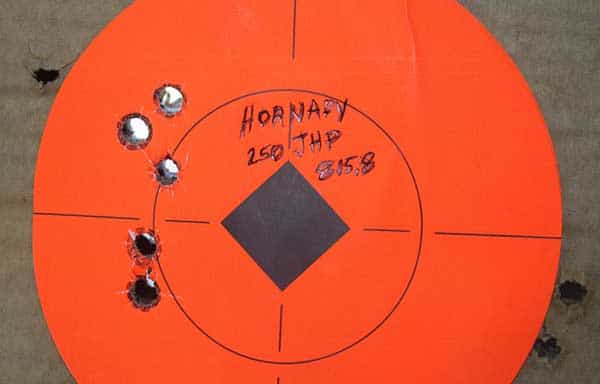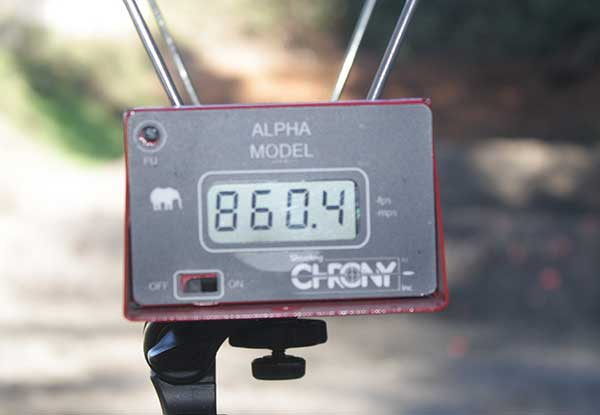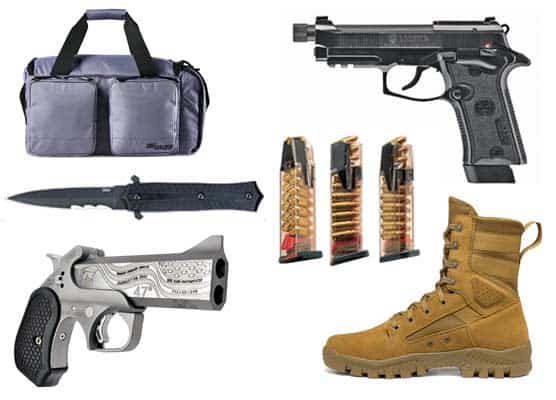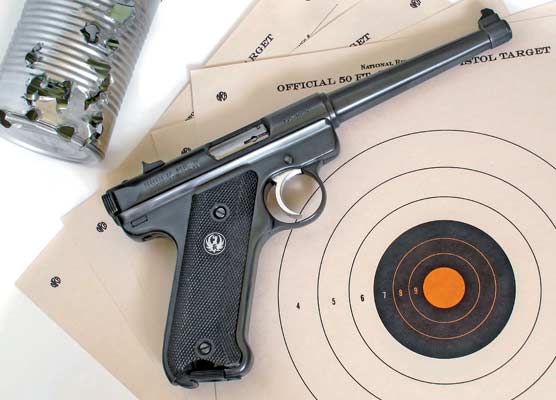Eight Rounds
Three For Velocity, Five For Accuracy Check
By the time you read this, my spring woodcutting should be well underway. In preparation for this annual enterprise — invariably conducted in an area where there are things with four legs, sharp teeth, claws and unpredictable tempers — I always like having a sidearm handy.
Since 2018, there have been two mountain lion attacks in my area, one of them fatal. I pay attention to that sort of thing since I don’t feel like being food.
Over the winter, I’ve been tinkering around with different loads for the .45 Colt, although a recent range visit reminded me of the effectiveness of my long-favorite setup of 6.9 grains of HP38 behind a 255-grain Hornady LFP bullet developed primarily for Cowboy Action shooters but a delightfully accurate projectile for guys like me who simply want to hit that at which we are shooting. This load consistently clocks above 850 fps, which is definitely enough horsepower to put the hurt on anything I might encounter in the west-central Cascades.
I have also been working with Hornady’s 250-grain JHP, pushed by 8 grains of AutoComp. The velocities I’ve been getting out of my Ruger New Vaquero with a 4 5/8-inch barrel have been coming in just over 800 fps, so I’ll be switching powder to CFE Pistol, which the Hodgdon Annual Manual tells me the maximum recommended charge is 8.8 grains for a published velocity of 915 fps. The game plan is to back that off to 8.7 grains and if it doesn’t come quite to 900 fps out of my sixgun, I’m okay with that.
One thing I’ve learned about shooting new loads or checking old favorites is that it really should only take eight rounds to figure things out. The first three I’ll put across the screens of my Chrony chronograph for a high, low and average, with the unit set about 30 inches ahead of the muzzle. Sure, you can fire more, which I’ve done many times, but it has been my experience — yours may vary, of course — that the average velocity one gets with three rounds will remain pretty consistent within 20-30 fps, whether you shoot five, seven or whatever number of rounds to get an idea of velocity.
Once I’ve established an average muzzle velocity, I’ll set a target out 10, 15 or 25 yards and cut loose off a good rest, slowly pacing five shots. That should be enough to establish where and how the gun shoots with a particular load. It has always worked this way for me.
While this particular exercise involved a single-action sixgun in .45 Colt, I’ve found the principle applies to other handguns I’ve fired and carried over the years. Three for speed, five for an accuracy check. The formula has helped put venison in the freezer on at least two occasions.
Grip Change Matters
This year, I’ve added a set of elk antler Sunday-go-Meeting grip panels to snazzy up my Ruger. They won’t always be on the grip frame, but I wanted to see if the swap from the Arizona Custom grip panels made a difference, and they do, just slightly.
With both loads mentioned above, I was shooting slightly to the left of center at 10 yards, probably because those elk grips fit just a bit differently in my hand, and the functional dimension of the overall grip surface changed ever so slightly. Not to worry, I’ll fix that with a few more range visits, but it’s something for others to keep in mind.
I’ve noticed the elk antler grips do offer the slightly rough center surface for a bit different feel, but even then, the sight picture doesn’t change, and I’ve learned over the years this New Vaquero is capable of decent and consistent accuracy, especially with the Hornady 255-grainers.
The .45 Colt is no slouch when it comes to ballistics. With the right loads, one can get some serious velocity without approaching disastrous chamber pressures. Remember, even Elmer Keith admitted to blowing up a sixgun one Fourth of July, a tale which my colleague Jeff “Tank” Hoover detailed in American Handgunner a while back. At reasonable range, the.45 Colt is an accurate cartridge, capable of bringing down deer, black bear and other game.
As a defensive round, the .45 Colt proved itself decisively from the get-go. There is probably no way to accurately count the number of people, on both sides of the law, who filled holes in various Boot Hill cemeteries from Dallas to Deadwood in the late 1800s and a lot of unmarked spots in between, courtesy of the .45 Colt.
Won’t Do That Again
A homeowner in East Oakland, Calif., was deemed to have acted in self-defense when he fatally shot a man identified as Charles Calloway, 39, during an attempted home invasion robbery.
According to the San Jose Mercury News, Calloway and an alleged accomplice broke into the residence on the evening of March 15. They probably did not expect a gunfight with the homeowner, but that’s exactly what they got. The homeowner was wounded in the foot, but it was Calloway who hit the floor and didn’t get back up.
The accomplice was apprehended 10 days later, thanks to something called “digital data” and video surveillance, along with witness statements, he was “charged with murder under the legal theory that he provoked the homeowner who killed Calloway into using lawful self-defense,” the newspaper explained.
On the Cutting Edge
For some reason, there has been an inexplicable uptick in the number of fatal and non-fatal knife attacks in several areas around the country.
The cases include fatal stabbings in West Palm Beach, Fla., Palo Alto, Calif., Beltsville, Md., and Portland, Ore., and non-fatal attacks in Seattle and Tacoma, Wash., and Chicago, Ill.
I chatted with Doug Ritter, founder of a group called Knife Rights. He suggested there might not be a surge but instead that the media is simply giving the problem more attention.
What the media isn’t doing is demanding “knife control,” and they’re not talking about “knife violence.” This is surprising since about three times as many people are murdered with knives during any given year as are killed with either rifles or shotguns. In 2022, the most recent year for which data is available, the FBI said 1,216 people were murdered with knives or “cutting instruments.” In the same year, 489 people were killed with rifles of any kind. Another 161 were murdered with shotguns, and 385 were slain with “other firearms.” More than 5,800 were killed with handguns and more than 4,500 with weapons simply identified as “firearm,” according to the FBI data.
One surprising weapon of choice is the common kitchen knife. You’ll find them in every residential kitchen in the country, every restaurant kitchen, and on sale in every department store. There are no background checks, no waiting periods, and literally no questions asked.







